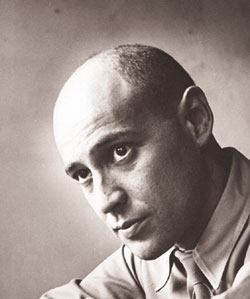March 26, 2007
Herman Stein Dead at 91
Was renowned 1950s sci-fi, horror composer by Jon Burlingame

Photo courtesy of David Schecter
During his years as a staff composer at Universal, which began in 1951, Stein contributed music to nearly 200 films, including westerns, comedies and dramas. But his most enduring legacy will be the music he wrote for several sci-fi and horror classics including It Came From Outer Space (1953), Creature From the Black Lagoon (1954), This Island Earth (1955), Tarantula (1955), The Mole People (1956) and The Incredible Shrinking Man (1957).
"Universal was a factory," Stein once said, helping to explain the fast pace and working conditions that led to single films being routinely assigned to multiple composers – and the resulting lack of screen credit to individual composers. Many Universal films of the era list only Joseph Gershenson, head of the department, as "music supervisor."
Stein worked alongside such other composers as Hans Salter, Henry Mancini, Heinz Roemheld, Frank Skinner and other stalwarts of the studio's music unit, in fashioning the musical backdrop of hundreds of films of the 1950s. B-movies were often scored in as little as a week in that era.
But in the case of the "monster movies," as producer David Schecter revealed in a recent series of thoroughly annotated re-recordings, Stein – in many cases – either composed the opening title music, which very often sets the tone for the entire picture, or the main themes from which he and his colleagues worked, or both. In some cases, such as This Island Earth, he wrote as much as 75 percent of the score.
The most prominent example may be the ascending three-note scare motif in Creature From the Black Lagoon and its sequels Revenge of the Creature (1955) and The Creature Walks Among Us (1956). Stein wrote that, and while he often pooh-poohed his musical contributions to those and other fantasy films of the era, there are few baby-boomers who grew up with those films, either at the movies or later on television, who wouldn't recognize it.
Stein's primary task was often to give credibility to these far-fetched scenarios – grounding the drama in some kind of reality that would help to convince the audience that what they were seeing on-screen was real. It was also about creating effective fright music: heightening the drama through the creative use of frequently intense, often dissonant material – sometimes shrill brass or screaming strings, sometimes strange or unearthly music using a theremin or Novachord.
Universal's screen-credit policy denied composers such as Stein the level of fame they may have deserved. The five releases (with more to come) of Schecter's Monstrous Movie Music label helped to correct that situation, and did so during Stein's lifetime. Ironically, it took Stein's death for the New York Times, Los Angeles Times and Associated Press to take notice of the high level of musical craftsmanship and memorable thematic material that Stein wrote for dozens of classics.
Among Stein's many other films were City Beneath the Sea (1953), The Glass Web (1953), The Black Shield of Falworth (1954), The Great Man (1956), Backlash (1956), No Name on the Bullet (1959) and his personal favorite, Roger Corman's anti-racism film The Intruder (1962), which starred a young William Shatner. In a 2000 interview with the Philadelphia Inquirer, Stein mentioned that he was also proud of a six-minute chase sequence composed for the obscure B film Girls in the Night (1953).
As his movie career was winding down, Stein turned his attention to television, where he composed scores for M Squad, Wagon Train, Daniel Boone, Voyage to the Bottom of the Sea, Lost in Space and other series.
While the more famous John Williams scored episodes 1, 3, 5 and 7 of Lost in Space, it is somewhat less known that Stein composed portions of episodes 2, 4, 6 and 8, including the familiar "family theme" – a warm and sweet melody that often accompanied scenes of the Robinson family having weathered yet another crisis, or John Robinson (Guy Williams) giving one of his pep talks about faith or optimism.
Stein also composed for cartoons (including the 1966 Speedy Gonzalez short Mucho Locos) and commercials. His work for the concert hall included Mock March for brass quintet and the cleverly titled Sour Suite for woodwind quintet.
Herman Stein was born August 19, 1915, in Philadelphia, began playing piano at the age of 3 and gave his first public recital at 6. He taught himself orchestration and was arranging professionally by the age of 15.
During the 1930s and '40s he composed and arranged for radio programs and jazz orchestras, including work for Count Basie, Bob Crosby, Red Norvo, Fred Waring and others. He moved to Los Angeles in 1948, studied composition with Mario Castelnuovo-Tedesco, and joined Universal in 1951. He retired in the mid-1960s.
His wife Anita, a violist for many years with the Los Angeles Philharmonic, died in 2001. There are no survivors.
©2007 Jon Burlingame